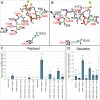Evolution of linear triterpenoid biosynthesis within the Euphorbia genus
- PMID: 40595524
- PMCID: PMC12219392
- DOI: 10.1038/s41467-025-60708-2
Evolution of linear triterpenoid biosynthesis within the Euphorbia genus
Abstract
Terpenoids are among the largest classes of plant natural products. Squalene, a high value commodity in the cosmetic, food and pharmaceutical industries, is a common linear precursor for the biosynthesis of C30 triterpenes and sterols across plant, animal and fungal kingdoms. The anti-fungal compound peplusol is another linear C30 triterpene, but has only been reported in the genus Euphorbia. Here, we show that peplusol production has evolved due to duplication of a sterol synthase gene with one copy acquiring peplusol synthase activity and the original gene retaining the ancestral function. We identify a number of key amino acid residues that can convert the squalene synthase enzyme into peplusol synthase and vice versa. The PEPLUSOL SYNTHASE gene from E. peplus is able to drive significant levels of peplusol production in alternate host production platforms including Nicotiana benthamiana (over 2.5% leaf dry weight) and Saccharomyces cerevisiae (30 mg/L culture).
© 2025. The Author(s).
Conflict of interest statement
Competing interests: The authors declare no competing interests.
Figures






Similar articles
-
Identification of BAHD-acyltransferase enzymes involved in ingenane diterpenoid biosynthesis.New Phytol. 2025 Sep;247(6):2591-2600. doi: 10.1111/nph.70388. Epub 2025 Jul 17. New Phytol. 2025. PMID: 40671640 Free PMC article.
-
Bioinformatics analysis and molecular cloning of squalene synthase from Simaroubaceae.Protein Expr Purif. 2025 Oct;234:106751. doi: 10.1016/j.pep.2025.106751. Epub 2025 May 30. Protein Expr Purif. 2025. PMID: 40451315
-
Phylogenomics and metabolic engineering reveal a conserved gene cluster in Solanaceae plants for withanolide biosynthesis.Nat Commun. 2025 Jul 10;16(1):6367. doi: 10.1038/s41467-025-61686-1. Nat Commun. 2025. PMID: 40640164 Free PMC article.
-
Foetal haemoglobin inducers for reducing blood transfusion in non-transfusion-dependent beta-thalassaemias.Cochrane Database Syst Rev. 2023 Jan 13;1(1):CD013767. doi: 10.1002/14651858.CD013767.pub2. Cochrane Database Syst Rev. 2023. PMID: 36637054 Free PMC article.
-
Deferasirox for managing iron overload in people with thalassaemia.Cochrane Database Syst Rev. 2017 Aug 15;8(8):CD007476. doi: 10.1002/14651858.CD007476.pub3. Cochrane Database Syst Rev. 2017. PMID: 28809446 Free PMC article.
References
-
- Chappell, J. The genetics and molecular genetics of terpene and sterol origami. Curr. Opin. Plant Biol.5, 151–157 (2002). - PubMed
-
- Thimmappa, R., Geisler, K., Louveau, T., O’Maille, P. & Osbourn, A. Triterpene biosynthesis in plants. Annu Rev. Plant Biol.65, 225–257 (2014). - PubMed
-
- Augustin, J. M., Kuzina, V., Andersen, S. B. & Bak, S. Molecular activities, biosynthesis and evolution of triterpenoid saponins. Phytochemistry72, 435–457 (2011). - PubMed
-
- Osbourn, A., Goss, R. J. & Field, R. A. The saponins: polar isoprenoids with important and diverse biological activities. Nat. Prod. Rep.28, 1261–1268 (2011). - PubMed
MeSH terms
Substances
Grants and funding
LinkOut - more resources
Full Text Sources

